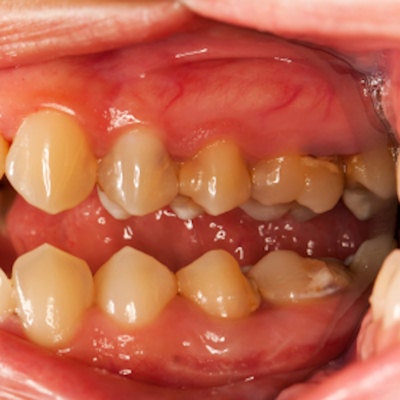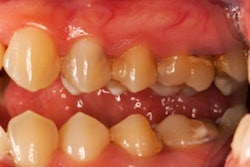
Periodontal disease is associated with a 14% increase in cancer risk among older women, according to the results of a new study. Periodontal disease also significantly increased the risk of specific cancers, including breast and esophageal cancers.
The study, which included thousands of older women with and without periodontal disease, was published in Cancer Epidemiology, Biomarkers & Prevention (August 1, 2017), a journal of the American Association for Cancer Research (AACR). The findings add to the scientific literature on the link between oral health and cancer risk.
 Senior author Jean Wactawski-Wende, PhD. Images courtesy of the AACR.
Senior author Jean Wactawski-Wende, PhD. Images courtesy of the AACR."This study is the first national study focused on women, particularly older women," stated senior author Jean Wactawski-Wende, PhD, in a press release. "Our study was sufficiently large and detailed enough to examine not just overall risk of cancer among older women with periodontal disease, but also to provide useful information on a number of cancer-specific sites."
Wactawski-Wende is a professor in the department of epidemiology and environmental health at the State University of New York School of Public Health and Health Professions in Buffalo. Ngozi Nwizu, BDS, PhD, from the University of Texas School of Dentistry at Houston, led the study, which also included co-authors from the Roswell Park Cancer Institute and University at Buffalo, both in Buffalo, NY.
Increased risk depends on cancer type
Previous research has linked periodontal disease to cancer, and periodontal pathogens have been found in precancerous and cancerous lesions. Nevertheless, few large-scale studies have investigated this link, and none has specifically targeted older women. With an aging population, researchers decided now was the ideal time to investigate a potential association between periodontal disease and cancer risk and also incidence in postmenopausal women.
 Lead author Ngozi Nwizu, BDS, PhD.
Lead author Ngozi Nwizu, BDS, PhD.The researchers began by using data from the Women's Health Initiative Observational Study (WHI-OS), an ongoing study that evaluates morbidity and mortality risk factors in older women. Between 1995 and 1998, postmenopausal women between the ages 50 and 79 were recruited for the WHI-OS, and study participants answered annual questionnaires about their health status.
Nearly 66,000 of the WHI-OS participants were included in the present study. The researchers used the WHI-OS Year 5 questionnaire as the baseline for analysis and excluded participants with missing survey information or who had a history of invasive cancer before year five.
About 1.5% of the 65,869 women surveyed developed cancer, and periodontal disease was associated with a 14% increase in risk for developing any type of cancer, as indicated by the hazard ratio of 1.14. For specific cancers, women with periodontal disease were more than three times more likely to develop esophageal cancer than those without periodontal disease. Periodontal disease was also associated with a significantly increased risk for melanoma and gallbladder, lung, and breast cancers.
| Risk of developing cancer in patients with periodontal disease | |
| Cancer type | Hazard ratio |
| Breast | 1.13 |
| All cancers | 1.14 |
| Melanoma | 1.23 |
| Lung | 1.31 |
| Gallbladder | 1.73 |
| Upper gastrointestinal tract (esophagus and stomach) |
2.04 |
| Esophageal | 3.28 |
"The esophagus is in close proximity to the oral cavity, and so periodontal pathogens may more easily gain access to and infect the esophageal mucosa and promote cancer risk at that site," Wactawski-Wende noted.
In addition, none of the other potentially confounding variables, including smoking status, alcohol intake, and diabetes history, had a large impact on risk, according to the authors. However, a history of smoking did significantly increase the risk for breast, lung, and gallbladder cancers. Somewhat surprisingly, though, periodontal disease did not significantly increase the risk for oropharyngeal cancers.
"Our lack of association with lip, oral, and pharynx cancers as a group may be due to the considerable heterogeneity between these anatomic subsites, and our relatively small number of cases, in comparison with previous reports with large numbers of head and neck cancer cases," the authors wrote.
Adding to the scientific literature
One of the main drawbacks of the study was that WHI-OS participants self-reported periodontal disease on the questionnaires, so periodontal disease data may have underreported, according to the authors. As a result, the disease risk estimates may be off, they noted. In addition, the women in the study tended to be more educated and less likely to be smokers than the general U.S. population.
Nevertheless, the large number of participants and lengthy follow-up time make the study a strong addition to the scientific literature. The findings confirm the need to continue studying the association between periodontal disease and other, systemic diseases, and they also provide new links between oral and systemic health, including being the first study to tie periodontal disease to gallbladder cancer in this population.
"Our study findings serve to provide further evidence that periodontal disease is linked to cancer and support the need for further investigation into how periodontal disease contributes to increased cancer risk," lead author Dr. Nwizu stated. "This may help direct cancer prevention strategies in the future, including the importance of maintaining good oral hygiene."


















